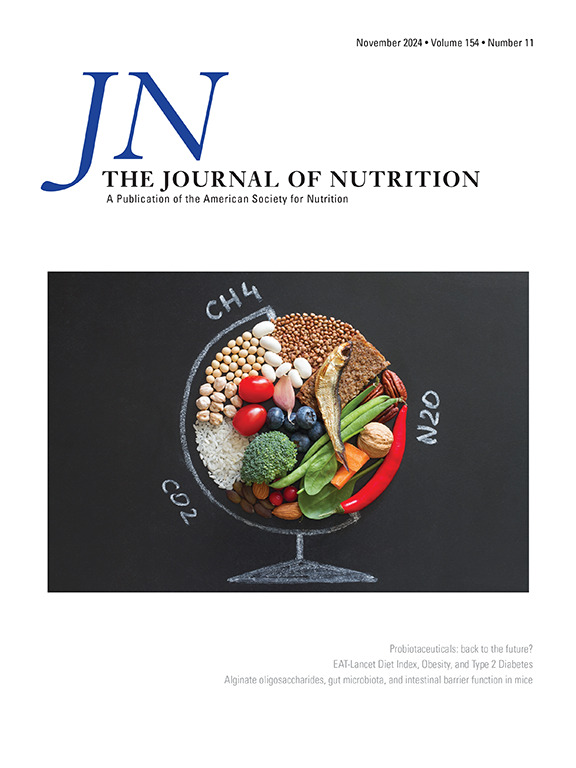Gastric Digestion and Changes in Serum Amino Acid Concentrations after Consumption of Casein from Cow and Goat Milk: A Randomized Crossover Trial in Healthy Males
IF 3.8
3区 医学
Q2 NUTRITION & DIETETICS
引用次数: 0
Abstract
Background
In vitro studies show that goat milk proteins form less compact coagulates in the stomach compared with cow milk proteins, which may facilitate gastric digestion and amino acid (AA) absorption. However, this has not been confirmed in vivo in humans.
Objectives
This study aims to examine gastric digestion and changes in serum AA concentrations after cow milk-derived (cow MC) and goat milk-derived casein (goat MC) ingestion.
Methods
In this single-blind randomized crossover study participants consumed 300 mL of a drink containing 30 g of cow MC or goat MC. Participants underwent gastric magnetic resonance imaging (MRI) scans at baseline and every 10 min ≤60 min postprandially. Blood was drawn at baseline and ≤4 h postprandially. In addition, participants verbally rated their appetite after each MRI measurement. Primary outcomes were gastric emptying and serum AA concentrations. Secondary outcome was gastric coagulation as inferred by image texture metrics.
Results
A total of 18 males (age 26 ± 8.3 y, body mass index 23 ± 1.6 kg/m2) completed the study. Gastric emptying half-time was 80 ± 25 min for goat and 85 ± 24 min for cow MC (P = 0.395). In line with this, gastric emptying of the drinks over time was similar [mean difference (MD) 0.77 mL; 95% confidence interval (CI): −6.9, 8.5; P = 0.845]. Serum essential AA (MD −110 μmol/L; 95% CI: −162, −58) was higher over time for cow MC (P < 0.001). The image texture metric contrast was lower for cow MC (MD 0.010; 95% CI: 0.001, 0.020; P = 0.036).
Conclusions
Cow and goat MC have different coagulating properties, as inferred by AA concentrations and supported by image texture analysis. However, overall gastric emptying and the emptying of the liquid and coagulated fractions were similar. This warrants further in vivo research on casein coagulation in the food matrix to help determine the optimal use for cow and goat milk and their protein fractions.
食用牛奶和羊奶酪蛋白后胃消化和血清氨基酸浓度的变化:一项健康男性的随机交叉试验
背景:体外研究表明,与牛奶蛋白相比,羊奶蛋白在胃中形成的凝结物更少,这可能有助于胃消化和氨基酸(AA)的吸收。然而,这还没有在人体中得到证实。目的:观察奶牛乳源性酪蛋白(cow MC)和羊乳源性酪蛋白(goat MC)摄入后胃消化和血清AA浓度的变化。方法:在这项单盲随机交叉研究中,参与者饮用300毫升含有30克牛MC或山羊MC的饮料。参与者在基线和每10分钟进行一次胃MRI扫描,直到餐后60分钟。在基线和餐后4小时抽血。此外,参与者在每次MRI测量后口头评价他们的食欲。主要结局是胃排空和血清AA浓度。次要结局是胃凝血,由图像纹理指标推断。结果:18名男性(年龄26±8.3岁,BMI 23±1.6 kg/m2)完成研究。山羊胃排空时间为80±25分钟,牛胃排空时间为85±24分钟(p = 0.395)。与此相一致,随着时间的推移,饮料的胃排空量相似(MD为0.77 ml, 95% CI [-6.9, 8.5], p=0.845)。血清必需AA (MD -110 μmol/L, 95% CI[-162, -58])随着时间的推移而升高(p结论:牛和山羊的MC具有不同的凝血特性,这是由AA浓度推断出来的,并得到图像纹理分析的支持。然而,总的胃排空和液体和凝固部分的排空是相似的。这就需要对食物基质中的酪蛋白凝固进行进一步的体内研究,以帮助确定牛奶和羊奶及其蛋白质组分的最佳用途。临床试验注册编号:NL8137(荷兰试验注册),可通过https://trialsearch.who.int/Trial2.aspx?TrialID=NL-OMON28580访问。
本文章由计算机程序翻译,如有差异,请以英文原文为准。
求助全文
约1分钟内获得全文
求助全文
来源期刊

Journal of Nutrition
医学-营养学
CiteScore
7.60
自引率
4.80%
发文量
260
审稿时长
39 days
期刊介绍:
The Journal of Nutrition (JN/J Nutr) publishes peer-reviewed original research papers covering all aspects of experimental nutrition in humans and other animal species; special articles such as reviews and biographies of prominent nutrition scientists; and issues, opinions, and commentaries on controversial issues in nutrition. Supplements are frequently published to provide extended discussion of topics of special interest.
 求助内容:
求助内容: 应助结果提醒方式:
应助结果提醒方式:


